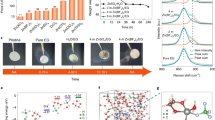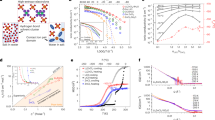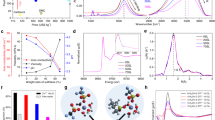Abstract
Among the more sustainable battery chemistries, the aqueous zinc system is receiving renewed interest. To accelerate the practical applications of this promising technology, an effective strategy is to deploy high salt concentration electrolytes that could address the critical technical barriers, notably hydrogen evolution reaction and dendrite growth at the anode side. However, the state-of-the-art recipes are either zinc-ion deficient or halogen salt dependent, both of which unfortunately create extra challenges. Here we show a highly concentrated aqueous electrolyte formula utilizing zinc acetate, an otherwise poorly water-soluble but cheap and eco-friendly salt. The unprecedented solubility (up to 23 m) is a result of the introduction of hydrotropic agents that transform the acetate anion ligands to a hydrophilic coordination structure. All three hydrotropic agents including potassium acetate, urea and acetamide are effective in constructing highly concentrated zinc acetate electrolytes with which the assembled Zn//pyrene-4,5,9,10-tetraone full cell retains 70% of its initial capacity after 4,000 cycles. This work provides a unique opportunity to design high-performance electrolytes for applications in the wide battery space.
This is a preview of subscription content, access via your institution
Access options
Access Nature and 54 other Nature Portfolio journals
Get Nature+, our best-value online-access subscription
$29.99 / 30 days
cancel any time
Subscribe to this journal
Receive 12 digital issues and online access to articles
$119.00 per year
only $9.92 per issue
Buy this article
- Purchase on Springer Link
- Instant access to full article PDF
Prices may be subject to local taxes which are calculated during checkout





Similar content being viewed by others
Data availability
The datasets generated and/or analysed during the current study are available from the corresponding authors on reasonable request.
References
Xie, J. & Lu, Y.-C. A retrospective on lithium-ion batteries. Nat. Commun. 11, 2499 (2020).
Bauer, C. et al. Charging sustainable batteries. Nat. Sustain. 5, 176–178 (2022).
Han, D. et al. A non-flammable hydrous organic electrolyte for sustainable zinc batteries. Nat. Sustain. 5, 205–213 (2022).
Jiang, H. et al. Chloride electrolyte enabled practical zinc metal battery with a near-unity coulombic efficiency. Nat. Sustain. https://doi.org/10.1038/s41893-41023-01092-x (2023).
Kundu, D., Adams, B. D., Duffort, V., Vajargah, S. H. & Nazar, L. F. A high-capacity and long-life aqueous rechargeable zinc battery using a metal oxide intercalation cathode. Nat. Energy 1, 16119 (2016).
Wang, F. et al. Highly reversible zinc metal anode for aqueous batteries. Nat. Mater. 17, 543–549 (2018).
Yang, C. et al. All-temperature zinc batteries with high-entropy aqueous electrolyte. Nat. Sustain. 6, 325–335 (2023).
Cao, L. et al. Fluorinated interphase enables reversible aqueous zinc battery chemistries. Nat. Nanotechnol. 16, 902–910 (2021).
Jin, Y. et al. Stabilizing zinc anode reactions by polyethylene oxide polymer in mild aqueous electrolytes. Adv. Funct. Mater. 30, 2003932 (2020).
Dong, Y. et al. Non-concentrated aqueous electrolytes with organic solvent additives for stable zinc batteries. Chem. Sci. 12, 5843–5852 (2021).
Wang, N. et al. Stabilized rechargeable aqueous zinc batteries using ethylene glycol as water blocker. ChemSusChem 13, 5556–5564 (2020).
Yang, W. et al. Hydrated eutectic electrolytes with ligand-oriented solvation shells for long-cycling zinc-organic batteries. Joule 4, 1557–1574 (2020).
Song, X. et al. Enhanced reversibility and electrochemical window of Zn-ion batteries with an acetonitrile/water-in-salt electrolyte. Chem. Commun. 57, 1246–1249 (2021).
Cao, L. et al. Solvation structure design for aqueous Zn metal batteries. J. Am. Chem. Soc. 142, 21404–21409 (2020).
Cui, J. et al. Improved electrochemical reversibility of Zn plating/stripping: a promising approach to suppress water-induced issues through the formation of H-bonding. Mater. Today Energy 18, 100563 (2020).
Wu, Y. et al. Electrolyte engineering enables stable Zn-ion deposition for long-cycling life aqueous Zn-ion batteries. Energy Storage Mater. 45, 1084–1091 (2022).
Lin, R., Ke, C., Chen, J., Liu, S. & Wang, J. Asymmetric donor-acceptor molecule-regulated core-shell-solvation electrolyte for high-voltage aqueous batteries. Joule 6, 399–417 (2022).
Chu, Y. et al. In situ built interphase with high interface energy and fast kinetics for high performance Zn metal anodes. Energy Environ. Sci. 14, 3609–3620 (2021).
Li, C. et al. Highly reversible Zn anode with a practical areal capacity enabled by a sustainable electrolyte and superacid interfacial chemistry. Joule 6, 1103–1120 (2022).
Parker, J. F. et al. Rechargeable nickel-3d zinc batteries: an energy-dense, safer alternative to lithium-ion. Science 356, 415–418 (2017).
Wang, Z. et al. A metal-organic framework host for highly reversible dendrite-free zinc metal anodes. Joule 3, 1289–1300 (2019).
Zhao, Z. et al. Long-life and deeply rechargeable aqueous Zn anodes enabled by a multifunctional brightener-inspired interphase. Energy Environ. Sci. 12, 1938–1949 (2019).
Zhu, Y. et al. Concentrated dual-cation electrolyte strategy for aqueous zinc-ion batteries. Energy Environ. Sci. 14, 4463–4473 (2021).
Chen, S. et al. Acetate-based ‘oversaturated gel electrolyte’ enabling highly stable aqueous zn-mno2 battery. Energy Storage Mater. 42, 240–251 (2021).
Ji, X. A perspective of ZnCl2 electrolytes: the physical and electrochemical properties. eScience 1, 99–107 (2021).
Zhang, C. et al. A ZnCl2 water-in-salt electrolyte for a reversible Zn metal anode. Chem. Commun. 54, 14097–14099 (2018).
Olbasa, B. W. et al. Highly reversible Zn metal anode stabilized by dense and anion-derived passivation layer obtained from concentrated hybrid aqueous electrolyte. Adv. Funct. Mater. 32, 2103959 (2021).
Zhao, J. et al. High-voltage Zn/LiMn0.8Fe0.2PO4 aqueous rechargeable battery by virtue of “water-in-salt” electrolyte. Electrochem. Commun. 69, 6–10 (2016).
Chen, S., Lan, R., Humphreys, J. & Tao, S. Salt-concentrated acetate electrolytes for a high voltage aqueous Zn/MnO2 battery. Energy Storage Mater. 28, 205–215 (2020).
Han, J., Mariani, A., Varzi, A. & Passerini, S. Green and low-cost acetate-based electrolytes for the highly reversible zinc anode. J. Power Sources 485, 229329 (2021).
Suo, L. et al. “Water-in-salt” electrolyte enables high-voltage aqueous lithium-ion chemistries. Science 350, 938–943 (2015).
Lukatskaya, M. R. et al. Concentrated mixed cation acetate “water-in-salt” solutions as green and low-cost high voltage electrolytes for aqueous batteries. Energy Environ. Sci. 11, 2876–2883 (2018).
Zhang, Y. et al. Pursuit of reversible Zn electrochemistry: a time-honored challenge towards low-cost and green energy storage. NPG Asia Mater. 12, 4 (2020).
Du, Y. et al. Electrolyte salts and additives regulation enables high performance aqueous zinc ion batteries: a mini review. Small 18, 2104640 (2021).
Ding, Y. et al. Insights into hydrotropic solubilization for hybrid ion redox flow batteries. ACS Energy Lett. 3, 2641–2648 (2018).
Orita, A., Verde, M. G., Sakai, M. & Meng, Y. S. A biomimetic redox flow battery based on flavin mononucleotide. Nat. Commun. 7, 13230 (2016).
Mu, L. et al. Anthraquinone derivative as high-performance anode material for sodium-ion batteries using ether-based electrolytes. Green Energy Environ. 3, 63–70 (2018).
Dhapte, V. & Mehta, P. Advances in hydrotropic solutions: an updated review. St. Petersburg Polytech. Univ. J. 1, 424–435 (2015).
Cao, J., Tao, M., Chen, H., Xu, J. & Chen, Z. A highly reversible anthraquinone-based anolyte for alkaline aqueous redox flow batteries. J. Power Sources 386, 40–46 (2018).
Kim, J. Y., Kim, S., Papp, M., Park, K. & Pinal, R. Hydrotropic solubilization of poorly water-soluble drugs. J. Pharm. Sci. Res. 99, 3953–3965 (2010).
Kunz, W., Holmberg, K. & Zemb, T. Hydrotropes. Curr. Opin. Colloid Interface Sci. 22, 99–107 (2016).
Vallet, V., Wahlgren, U. & Grenthe, I. Chelate effect and thermodynamics of metal complex formation in solution: a quantum chemical study. J. Am. Chem. Soc. 125, 14941–14950 (2003).
Findoráková, L. et al. Novel zinc(ii) benzoate complex compounds with caffeine and urea. J. Therm. Anal. Calorim. 95, 923–928 (2009).
Deacon, G. B. & Phillips, R. J. Relationships between the carbon-oxygen stretching frequencies of carboxylato complexes and the type of carboxylate coordination. Coord. Chem. Rev. 33, 227–250 (1980).
Chen, R. et al. Zwitterionic bifunctional layer for reversible Zn anode. ACS Energy Lett. 7, 1719–1727 (2022).
Linert, W., Jameson, R. F. & Taha, A. Donor numbers of anions in solution: the use of solvatochromic Lewis acid–base indicators. J. Chem. Soc. Dalton Trans. https://doi.org/10.1039/DT9930003181 (1993).
Bai, P., Li, J., Brushett, F. R. & Bazant, M. Z. Transition of lithium growth mechanisms in liquid electrolytes. Energy Environ. Sci. 9, 3221–3229 (2016).
Pang, Q. et al. Fast-charging aluminium–chalcogen batteries resistant to dendritic shorting. Nature 608, 704–711 (2022).
Yamada, Y., Wang, J., Ko, S., Watanabe, E. & Yamada, A. Advances and issues in developing salt-concentrated battery electrolytes. Nat. Energy 4, 269–280 (2019).
Cong, G., Zhou, Y., Li, Z. & Lu, Y.-C. A highly concentrated catholyte enabled by a low-melting-point ferrocene derivative. ACS Energy Lett. 2, 869–875 (2017).
Hou, S. et al. Solvation sheath reorganization enables divalent metal batteries with fast interfacial charge transfer kinetics. Science 374, 172–178 (2021).
Meng, R. et al. Tuning Zn‐ion solvation chemistry with chelating ligands toward stable aqueous Zn anodes. Adv. Mater. 34, 2200677 (2022).
Ko, S. et al. Electrode potential influences the reversibility of lithium-metal anodes. Nat. Energy 7, 1217–1224 (2022).
Yamada, Y. et al. Hydrate-melt electrolytes for high-energy-density aqueous batteries. Nat. Energy 1, 16129 (2016).
Cai, S. et al. Water–salt oligomers enable supersoluble electrolytes for high-performance aqueous batteries. Adv. Mater. 33, 2007470 (2021).
Jiang, L. et al. High-voltage aqueous Na-ion battery enabled by inert-cation-assisted water-in-salt electrolyte. Adv. Mater. 32, 1904427 (2020).
Sui, Y. & Ji, X. Anticatalytic strategies to suppress water electrolysis in aqueous batteries. Chem. Rev. 121, 6654–6695 (2021).
Zhao, J. et al. “Water-in-deep eutectic solvent” electrolytes enable zinc metal anodes for rechargeable aqueous batteries. Nano Energy 57, 625–634 (2019).
Zhang, Q. et al. Modulating electrolyte structure for ultralow temperature aqueous zinc batteries. Nat. Commun. 11, 4463 (2020).
Xie, J., Liang, Z. & Lu, Y.-C. Molecular crowding electrolytes for high-voltage aqueous batteries. Nat. Mater. 19, 1006–1011 (2020).
Dong, D., Xie, J., Liang, Z. & Lu, Y.-C. Tuning intermolecular interactions of molecular crowding electrolyte for high-performance aqueous batteries. ACS Energy Lett. 7, 123–130 (2022).
Cai, Z. et al. Chemically resistant Cu–Zn/Zn composite anode for long cycling aqueous batteries. Energy Storage Mater. 27, 205–211 (2020).
Ma, L. et al. Ammonium enables reversible aqueous Zn battery chemistries by tailoring the interphase. One Earth 5, 413–421 (2022).
Suo, L., Hu, Y.-S., Li, H., Armand, M. & Chen, L. A new class of solvent-in-salt electrolyte for high-energy rechargeable metallic lithium batteries. Nat. Commun. 4, 1481 (2013).
Gonzalez, G., Marshall, G., Molina, F. V., Dengra, S. & Rosso, M. Viscosity effects in thin-layer electrodeposition. J. Electrochem. Soc. 148, C479 (2001).
Guo, Z. et al. An environmentally friendly and flexible aqueous zinc battery using an organic cathode. Angew. Chem. Int. Ed. 57, 11737–11741 (2018).
Evans, J., Vincent, C. A. & Bruce, P. G. Electrochemical measurement of transference numbers in polymer electrolytes. Polymer 28, 2324–2328 (1987).
Ravel, B. & Newville, M. ATHENA, ARTEMIS, HEPHAESTUS: data analysis for X-ray absorption spectroscopy usingIFEFFIT. J. Synchrotron Radiat. 12, 537–541 (2005).
Grimme, S., Antony, J., Ehrlich, S. & Krieg, H. A consistent and accurate ab initio parametrization of density functional dispersion correction (DFT-D) for the 94 elements H-Pu. J. Chem. Phys. 132, 154104 (2010).
Iannuzzi, M., Laio, A. & Parrinello, M. Efficient exploration of reactive potential energy surfaces using Car-Parrinello molecular dynamics. Phys. Rev. Lett. 90, 238302 (2003).
Li, P., Song, L. F. & Merz, K. M. Jr. Systematic parameterization of monovalent ions employing the nonbonded model. J. Chem. Theory Comput. 11, 1645–1657 (2015).
Wang, J., Wolf, R. M., Caldwell, J. W., Kollman, P. A. & Case, D. A. Development and testing of a general amber force field. J. Comput. Chem. 25, 1157–1174 (2004).
Wang, J., Cieplak, P. & Kollman, P. A. How well does a restrained electrostatic potential (resp) model perform in calculating conformational energies of organic and biological molecules? J. Comput. Chem. 21, 1049–1074 (2000).
Lu, T. & Chen, F. Multiwfn: a multifunctional wavefunction analyzer. J. Comput. Chem. 33, 580–592 (2012).
Neese, F., Wennmohs, F., Becker, U. & Riplinger, C. The orca quantum chemistry program package. J. Chem. Phys. 152, 224108 (2020).
Martínez, L., Andrade, R., Birgin, E. G. & Martínez, J. M. Packmol: a package for building initial configurations for molecular dynamics simulations. J. Comput. Chem. 30, 2157–2164 (2009).
Brehm, M., Thomas, M., Gehrke, S. & Kirchner, B. Travis—a free analyzer for trajectories from molecular simulation. J. Chem. Phys. 152, 164105 (2020).
Humphrey, W., Dalke, A. & Schulten, K. Vmd: visual molecular dynamics. J. Mol. Graph. 14, 33–38 (1996).
Acknowledgements
The work described in this paper was fully supported by two grants from the Research Grant Council of the Hong Kong Special Administrative Region, China (No. CUHK14308321, Y.-C.L. and C1002-21GF, Y.-C.L. and J.F.). We thank Z. J. Liang and J. Xie for the OEMS tests, J. F. Lei and W. W. Wang for the SEM tests, and L. W. Jiang for insightful discussion of the mechanism.
Author information
Authors and Affiliations
Contributions
D.D. and Y.-C.L. conceived the project; D.D. carried out electrochemical tests and characterizations; T.W. and J.F. conducted MD simulations. Y.S. carried out cathode synthesis. D.D. and Y.-C.L. wrote the paper; all authors participated in manuscript preparation.
Corresponding author
Ethics declarations
Competing interests
The authors declare no competing interests.
Peer review
Peer review information
Nature Sustainability thanks Fei Wang and the other, anonymous, reviewer(s) for their contribution to the peer review of this work.
Additional information
Publisher’s note Springer Nature remains neutral with regard to jurisdictional claims in published maps and institutional affiliations.
Supplementary information
Supplementary Information
Supplementary Figs. 1–30, Tables 1–9, and Notes 1 and 2.
Rights and permissions
Springer Nature or its licensor (e.g. a society or other partner) holds exclusive rights to this article under a publishing agreement with the author(s) or other rightsholder(s); author self-archiving of the accepted manuscript version of this article is solely governed by the terms of such publishing agreement and applicable law.
About this article
Cite this article
Dong, D., Wang, T., Sun, Y. et al. Hydrotropic solubilization of zinc acetates for sustainable aqueous battery electrolytes. Nat Sustain 6, 1474–1484 (2023). https://doi.org/10.1038/s41893-023-01172-y
Received:
Accepted:
Published:
Issue Date:
DOI: https://doi.org/10.1038/s41893-023-01172-y
This article is cited by
-
Best practices for zinc metal batteries
Nature Sustainability (2024)
-
A Review of Rechargeable Zinc–Air Batteries: Recent Progress and Future Perspectives
Nano-Micro Letters (2024)
-
Critical Solvation Structures Arrested Active Molecules for Reversible Zn Electrochemistry
Nano-Micro Letters (2024)
-
Regulation of aqueous electrolyte interface via electrolyte strategies for uniform zinc deposition
Nano Research (2024)



